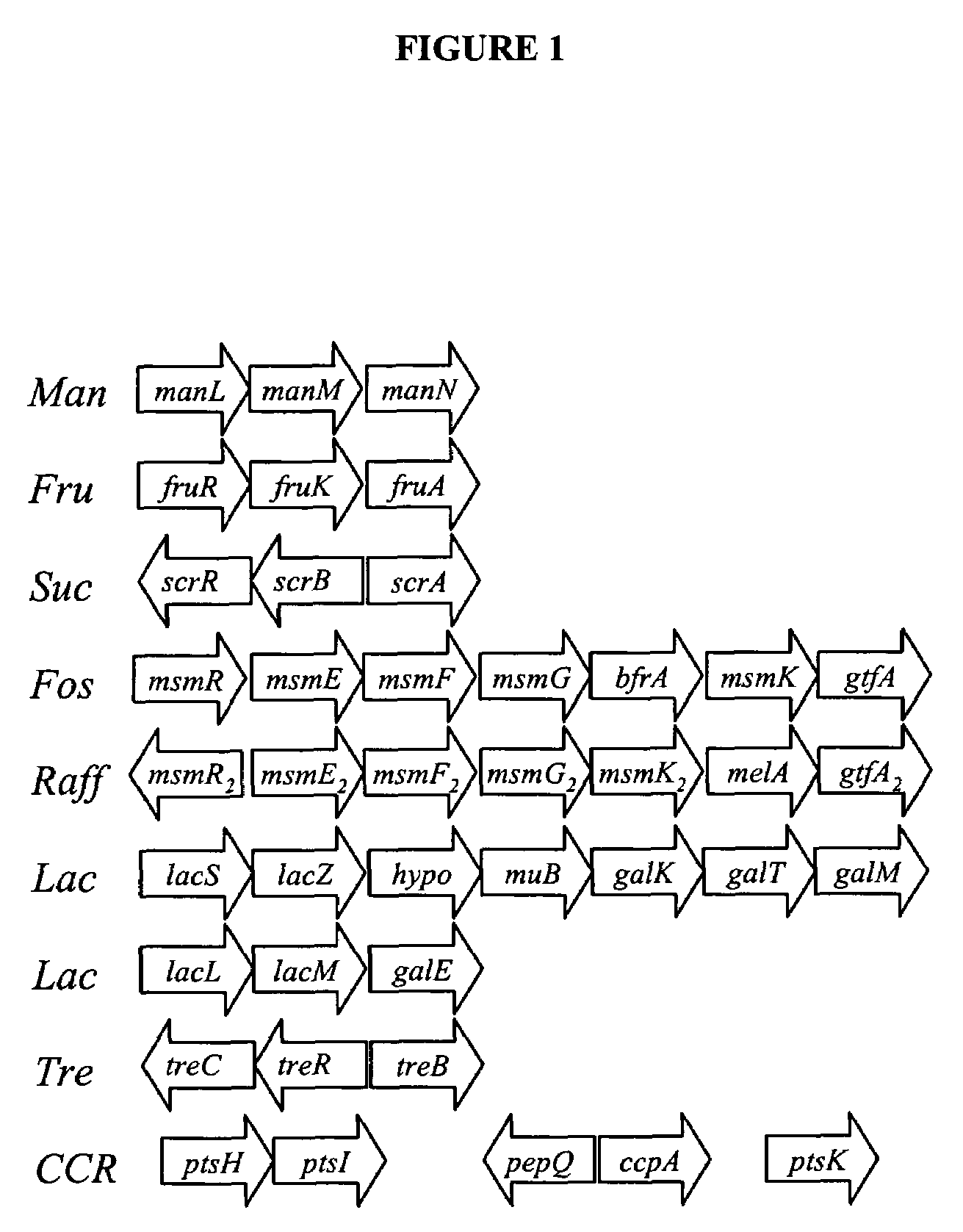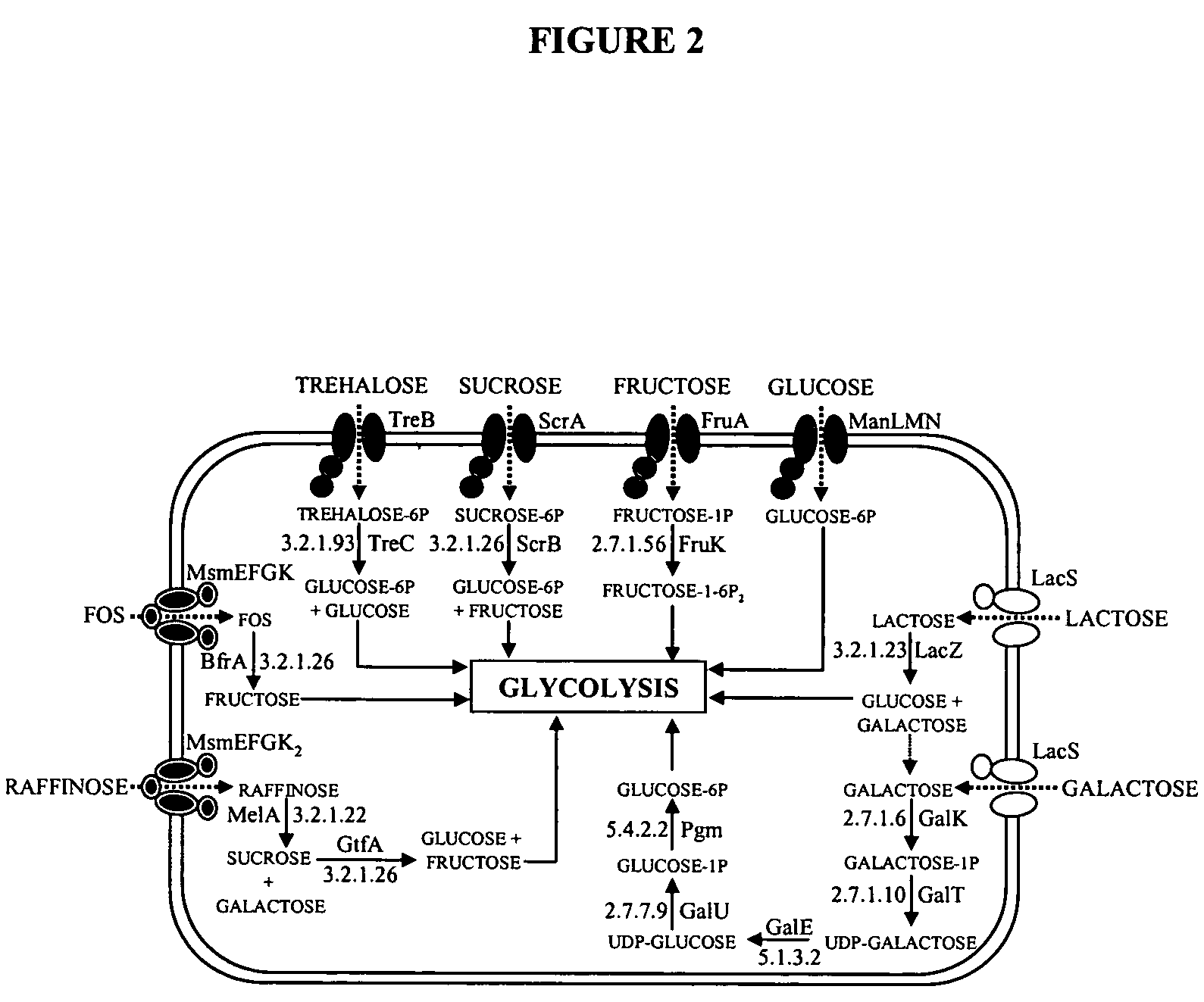Lactobacillus acidophilus nucleic acid sequences encoding carbohydrate utilization-related proteins and uses therefor
a technology of carbohydrate utilization and nucleic acid sequences, applied in the field of polynucleotides isolated from lactic acid bacteria, can solve the problems of interfering with the growth of undesirable bacteria, pathogens, yeasts, etc., and achieve the effects of improving fermentative abilities, surviving stress, and altering flavors or textures
- Summary
- Abstract
- Description
- Claims
- Application Information
AI Technical Summary
Benefits of technology
Problems solved by technology
Method used
Image
Examples
example 1
Gapped BlastP Results for Amino Acid Sequences
[0172]A Gapped BlastP sequence alignment showed that SEQ ID NO:2 (144 amino acids) has about 61% identity from amino acids 1-140 with a protein from Listeria innocua that is homologous to a PTS system mannose-specific factor IIAB (Accession Nos. NP—469488.1; NC—003212), about 60% identity from amino acids 1-140 with a protein from Listeria monocytogenes that is homologous to a PTS system mannose-specific factor IIAB (Accession Nos. NP—463629.1; NC—003210), about 63% identity from amino acids 1-139 with a protein from Clostridium acetobutylicum that is a mannose-specific phosphotransferase system component IIAB (Accession Nos. NP—149230.1; NC—001988), about 62% identity from amino acids 1-139 with a protein from Clostridium perfringens that is a PTS system protein (Accession Nos. NP—561737.1; NC—003366), and about 50% identity from amino acids 2-141 with a protein from Streptococcus pyogenes that is a mannose-specific phosphotransferase s...
example 2
PFAM Results for Amino Acid Sequences
[0261]Table 3 shows the top PFAM results for the amino acid sequences of the invention.
[0262]
TABLE 3PFAM Results for Amino Acid SequencesAmino AcidSEQ IDRangeNO:ORFDomainStart, StopFamilyPFAM Accession No.E-value3877PTS_IIA16, 111PTS system, Lactose / Cellobiose specific IIAPF022558.20E−40subunit5609PTS_EIIA_130, 134phosphoenolpyruvate-dependent sugarPF003586.00E−55phosphotransferase system, EIIA 171479PRD76, 171;PRD domainPF008749.90E−52181, 28271479CAT_RBD6, 67CAT RNA binding domainPF031231.10E−1691574Glyco_hydro_14, 471Glycosyl hydrolase family 1PF002322.90E−133111707PTS_EIIA_1491, 595phosphoenolpyruvate-dependent sugarPF003586.10E−53phosphotransferase system, EIIA 1111707PTS_EIIC105, 387Phosphotransferase system, EIICPF023783.10E−33111707PTS_EIIB7, 41phosphotransferase system, EIIBPF003678.50E−1913725PTS_EIIA_1528, 632phosphoenolpyruvate-dependent sugarPF003584.10E−60phosphotransferase system, EIIA 113725PTS_EIIC122, 419Phosphotransferase syste...
example 3
Sugar Metabolism Genes
[0263]Lactobacillus acidophilus has the ability to utilize a variety of carbohydrates, including mono-, di- and poly-saccharides, as shown by its API50 sugar fermentation pattern. In particular, complex dietary carbohydrates that escape digestion in the upper GI-tract, such as raffinose and fructooligosaccharides (Gibson et al. (1995) J. Nutr. 125:1401-1412; Barrangou et al. (2003) Proc. Natl. Acad. Sci. U.S. A 100:8957-8962) can be utilized. The NCFM genome encodes a large variety of genes related to carbohydrate utilization, including 20 phosphoenolpyruvate sugar-transferase systems (PTS) and 5 ATP binding cassette (ABC) families of transporters. Putative PTS transporters were identified for trehalose (ORF 1012)(SEQ ID NOS:103 and 289), fructose (ORF 1777) (SEQ ID NO:35), sucrose (ORF 401) (SEQ ID NO:101), glucose and mannose (ORF 452 (SEQ ID NOS:1 and 263), ORF 453 (SEQ ID NO:161), ORF 454 (SEQ ID NO:163), ORF 455 (SEQ ID NO:165) and ORF 456 (SEQ ID NO:167))...
PUM
| Property | Measurement | Unit |
|---|---|---|
| temperature | aaaaa | aaaaa |
| temperature | aaaaa | aaaaa |
| pH | aaaaa | aaaaa |
Abstract
Description
Claims
Application Information
 Login to View More
Login to View More - R&D
- Intellectual Property
- Life Sciences
- Materials
- Tech Scout
- Unparalleled Data Quality
- Higher Quality Content
- 60% Fewer Hallucinations
Browse by: Latest US Patents, China's latest patents, Technical Efficacy Thesaurus, Application Domain, Technology Topic, Popular Technical Reports.
© 2025 PatSnap. All rights reserved.Legal|Privacy policy|Modern Slavery Act Transparency Statement|Sitemap|About US| Contact US: help@patsnap.com


